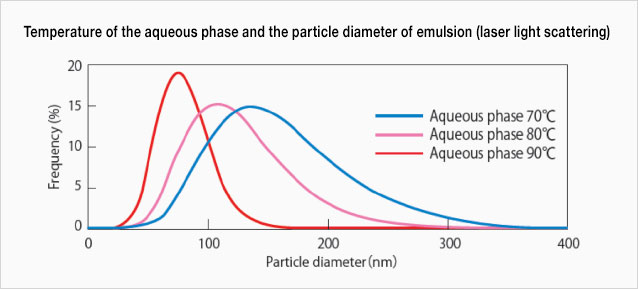Eye drops are composed mainly of water. However, the active ingredient vitamin A is fat-soluble, so, like oil, it cannot be dissolved homogeneously into water just by mixing. In addition, vitamin A easily breaks down in aqueous solution. As a result, although the positive effect of vitamin A on eye health has long been well known, it has been difficult to use in eye drop formulas. Moreover, under Japan’s Pharmaceutical Affairs Law, OTC eye drops sold at pharmacies and drug stores must be limpid (clear and transparent), making it even more difficult to use vitamin A in eye drop formulations.
To overcome these difficulties and incorporate fat-soluble vitamin A into eye drops required the application of interface science-based technologies. Lion has built up technologies related to interface science over many years through the development of detergents and other products. More than two decades ago, Lion led the way in establishing the technology to stabilize vitamin A in OTC eye drops using surfactants.
Even more than 20 years after the release of the Smile eye drop series, Lion’s researchers continued to advance R&D, driven by the strong desire to create even better eye drops. The key technological challenges were to include a higher amount of vitamin A without producing a cloudy liquid and to increase the amount of vitamin A in the formula that adsorbs on the cornea.
However, the vitamin A in Lion’s eye drops was enveloped by the surfactant within the solution. As a result, increasing the amount of vitamin A in the solution also required increasing the amount of surfactant, limiting adsorption on the cornea. However, if the amount of surfactant were reduced to improve absorbability, the emulsion particle size would become larger, causing the liquid to appear cloudy.

During formula development, we reviewed the existing manufacturing process from scratch, focusing on the fact that the emulsion particle size changes depending on the formulation process. If the emulsion particle size could be made sufficiently smaller than any visible light wavelength, the solution would be transparent.
First, we measured the amount of vitamin A adsorbed using liposomes to model cornea cells in order to determine the proportion of surfactant that would improve the vitamin A adsorbability compared with the existing formula. We then thoroughly studied the formulation process at the promising level of surfactant identified through this process. We discovered that by raising the temperature of the aqueous phase, the particle diameter could be made smaller. In addition, we analyzed the resulting solution using the small-angle X-ray scattering (SAXS) method, a cutting-edge structural analysis technology, and found that the vitamin A was dispersed in the water in extremely small nano particles, forming a nano-emulsion.*
By extending the scope of technological development from examining only the quantitative ratio of surfactant to include the manufacturing process as well, we succeeded in creating a formula with more vitamin A and higher adsorbability without decreasing limpidness.

*Academic Presentations:
The 28th Annual Meeting of the Academy of Pharmaceutical Science and Technology, Japan (2013). Formulation design of eye drops with vitamin A emulsion with absorbability.
The 52nd Annual Meeting of Japan Oil Chemists’ Society (2013). Structure of vitamin A nano-emulsions prepared with non-ionic surfactants and its absorbability onto the biological-model interface.